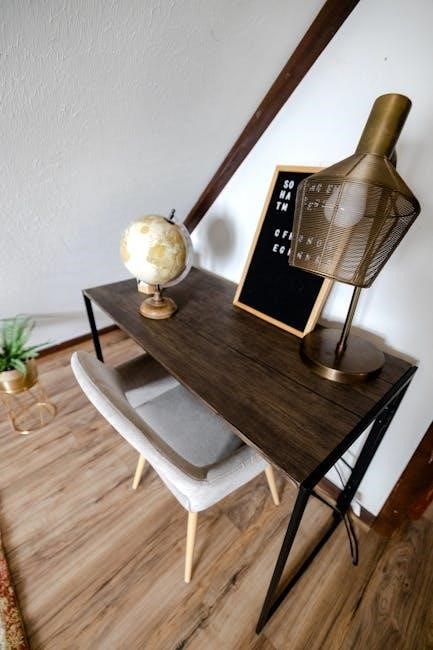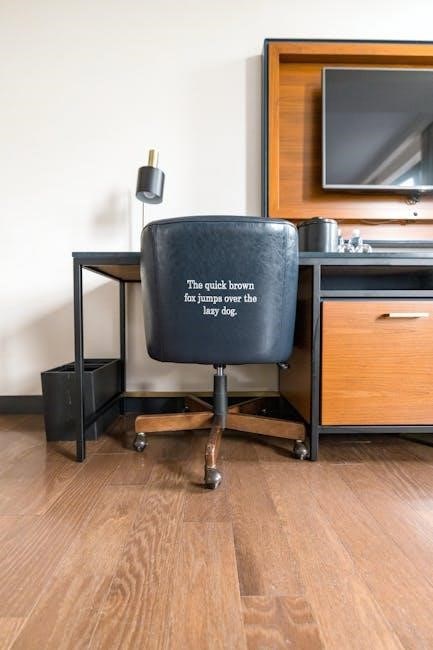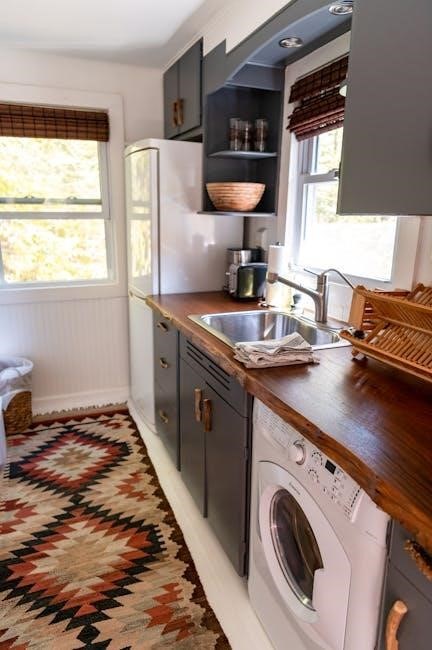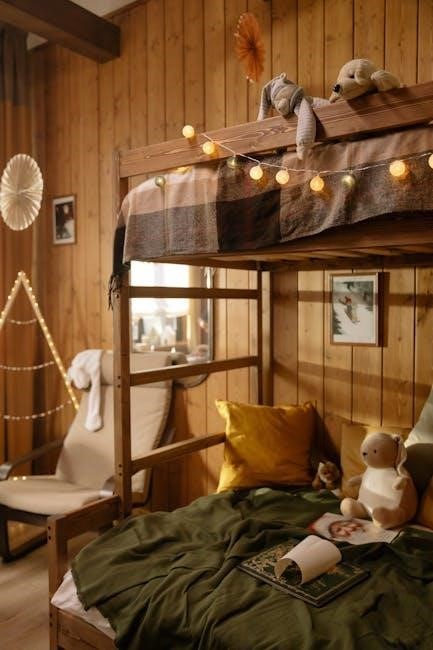A futon bunk bed is a space-saving solution offering versatility and comfort. It combines a sofa and bed, ideal for small spaces. Follow assembly instructions carefully for safety and functionality.
Understanding the Futon Bunk Bed
A futon bunk bed is a versatile, multifunctional piece of furniture designed to save space while offering comfort and practicality. It typically features a wooden or metal frame with a bunk bed structure, combining a sofa and a bed in one unit. The bottom section can often convert from a daybed to a full-size bed, making it ideal for small rooms or guest areas. The upper bunk provides additional sleeping space, while guardrails ensure safety. The futon mechanism allows easy transformation from a sofa to a bed, with some models requiring the removal of hooks for conversion. Always follow assembly instructions carefully to ensure stability and functionality.

Understanding the Product
The futon bunk bed is a multifunctional, wooden bunk bed with a convertible bottom that can serve as a daybed or a full-size bed when fully extended.
Key Features and Components
The futon bunk bed features a wooden frame, a convertible bottom that transforms from a daybed to a full-size bed, and a spring hinge mechanism for easy conversion. It includes side panels labeled for proper assembly orientation, support slats for stability, and guardrails for the upper bunk to ensure safety. The product comes with essential hardware like bolts, washers, and nuts, along with tools for assembly. The dimensions of the full bed are 76 inches in length and 54.4 inches in width, making it suitable for various spaces. The bunk bed also includes a ladder for accessing the upper bunk, enhancing functionality and accessibility.
Types of Futon Bunk Beds
Futon bunk beds come in various styles to suit different needs. The standard model features a futon sofa on the lower level and a bunk bed above, while some designs include a convertible bottom that can be pulled out to form a full-size bed. Certain models offer twin-over-queen configurations, providing additional space for larger families. Some bunk beds include storage drawers or trundles for extra convenience. Materials vary, with options like solid wood or metal frames, each offering durability and aesthetic appeal. Specialized designs may include built-in guardrails, ladders, or adjustable features for enhanced functionality. These versatile beds cater to diverse preferences, blending practicality with comfort for modern living spaces.
Size Options and Dimensions
Futon bunk beds are available in various sizes to accommodate different spaces and needs. The full bed dimension typically measures 76L x 54.4W inches, offering ample space for comfort. Twin and queen-sized options are also common, catering to smaller rooms or larger families. Compact models are ideal for tight spaces, while taller designs provide additional storage or accessibility. Adjustable features allow customization to fit specific room layouts. Height considerations are crucial for safety, especially for children, ensuring easy access to the upper bunk. Always measure your room to ensure the bed fits seamlessly, optimizing functionality and comfort in any setting. Proper sizing ensures stability and usability, making it essential to choose dimensions that align with your space requirements.

Safety Considerations
Always use guardrails on the upper bunk for fall prevention. Ensure the bed is stable and securely assembled. Follow weight limits and safety precautions strictly.
General Safety Precautions
Always follow the assembly instructions carefully and avoid skipping steps. Ensure all screws and bolts are tightened securely before use. Use guardrails on the upper bunk to prevent falls, especially if placed near a wall. Keep small parts away from children and ensure adult supervision during assembly. Avoid standing on the bed for safety. Place the bunk bed on a firm, level surface to maintain stability. Regularly inspect the frame for loose parts and tighten as needed. Follow weight limits and safety guidelines provided by the manufacturer. By adhering to these precautions, you can ensure a safe and durable futon bunk bed for years to come. Always prioritize safety for all users.
Weight Limits and Restrictions
Adhere to the weight limits specified by the manufacturer to ensure safety and durability. Typically, the upper bunk has a lower weight capacity compared to the lower bunk. Exceeding these limits can lead to structural damage or collapse. Most futon bunk beds have a weight capacity of 200-400 lbs for the upper bunk and 400-600 lbs for the lower bunk, depending on the model. Avoid placing heavy objects or multiple users on the upper bunk. Always check the product manual for specific weight restrictions; Exceeding these limits can compromise safety and void the warranty. Ensure all users, especially children, understand and follow these guidelines to prevent accidents. Regularly inspect the bed for signs of strain or damage.

Tools and Equipment Needed
Essential tools include an Allen wrench, screwdriver, bolts, washers, and nuts. Optional tools like a drill or rubber mallet may aid assembly. Ensure all parts are included for proper construction.
Essential Tools for Assembly
Assembling a futon bunk bed requires specific tools to ensure a smooth and secure setup. The essential tools include an Allen wrench, typically provided with the bed, for tightening bolts and screws. A screwdriver, preferably a Phillips-head, is necessary for securing slats and other components. Additionally, a set of wrenches or pliers may be needed to tighten bolts firmly. Ensure all hardware, such as nuts, washers, and bolts, is included in the package. Having a rubber mallet on hand can help tap pieces into place without causing damage. Always refer to the instruction manual for specific tool recommendations, as some models may require specialized equipment. Organize all parts and tools beforehand to streamline the assembly process.
Optional Tools for Convenience
While essential tools are necessary for assembly, optional tools can enhance convenience and efficiency. A cordless drill with screwdriver and drill bits can speed up tasks like driving screws or pre-drilling holes. Clamps or vice grips can hold parts in place, ensuring stability while tightening bolts. A step stool or small ladder may be helpful for reaching higher sections of the bunk bed. A measuring tape can assist in verifying dimensions and alignment. A marker or pencil can mark screw holes or label parts for easier identification. A socket set may be useful if bolts require extra torque. Lastly, a work light can provide better visibility in low-lit areas. These tools are not mandatory but can make the process smoother and less frustrating.

Preparation for Assembly
Preparation is key to a smooth assembly. Clear the workspace, gather all tools, and plan the layout. Ensure everything is organized to save time and effort.
Choosing the Right Location
When selecting a location for your futon bunk bed, consider the room’s dimensions and layout. Measure the space carefully to ensure the bed fits comfortably. Position it away from direct sunlight to prevent fading. Ensure the area is level and sturdy, especially if placing it on a carpeted floor, as this may require additional support. Avoid areas near heaters or sharp objects for safety. Consider the room’s functionality—place it near a window for natural light or in a corner for a cozy setup. Ensure there’s enough clearance around the bed for easy access and movement. Finally, check doorways and hallways to confirm the bed can be moved into the room without obstruction.
Unpacking and Organizing Parts
Begin by carefully unpacking the futon bunk bed components from the boxes. Inspect each part for damage or defects. Organize the hardware, such as screws, bolts, and Allen wrenches, in a designated container to avoid misplacement. Separate the larger components, like side panels and frames, and label them for easy identification. Use the provided inventory list to ensure all parts are included. Arrange the parts in a logical order based on the assembly sequence. Consider grouping similar items together, such as all screws or brackets, to streamline the process. Place small parts in ziplock bags or a tray to prevent loss. Cover the work area with a protective cloth to prevent damage to the components during assembly.

Assembly Instructions
Begin by following the step-by-step guide, using the provided tools to assemble components. Ensure all parts are properly aligned and securely fastened. Follow safety guidelines to prevent injuries and verify all parts are included before starting. Having a second person assist can make the process easier and safer.
Preparing the Side Panels and Frame
Start by carefully unpacking the side panels and frame components. Use an Allen wrench to loosen any pre-assembled bolts. Place the panels on a flat surface, ensuring they are aligned with the pre-drilled holes. Attach the legs or feet to the panels using the provided screws, tightening firmly. Next, align the frame rails with the panels, securing them with bolts. Double-check the alignment to ensure stability. Once the basic structure is in place, proceed to the next step. Always refer to the manual for specific bolt torque settings. Ensure all parts are tightly secured to avoid wobbling. Safety is paramount, so double-check every connection before moving forward with assembly.
Assembling the Side Panels
Begin by aligning the side panels with the pre-drilled holes on the frame. Use the provided Allen wrench to secure the panels using the bolts and washers. Tighten firmly but avoid overtightening, which may strip the threads. Ensure the panels are upright and evenly spaced. If your model includes support brackets, attach them to the inside of the panels for added stability. Once the panels are in place, use a level to confirm they are perfectly vertical. Secure any additional hardware, such as safety brackets, to prevent shifting. Double-check all connections for tightness before proceeding to the next step. Proper alignment is crucial for the overall stability of the bunk bed.
Attaching the Support Slats
Begin by identifying the support slats, typically thin, flat pieces of wood or metal designed to provide additional stability to the bunk bed. Locate the pre-drilled holes on the side panels where the slats will be attached. Place the slats evenly across the frame, ensuring they align with the holes. Use the provided bolts or screws to secure the slats tightly. Make sure the slats are flush with the frame to avoid any protrusions. Tighten all connections firmly, but do not overtighten, as this may damage the material. Double-check the slats for proper alignment and spacing to ensure even weight distribution. This step is critical for the structural integrity and safety of the bunk bed.
Installing the Futon Frame
Position the futon frame on top of the support slats, ensuring proper alignment with the side panels. Locate the pre-drilled holes on the frame and slats. Use the provided bolts or screws to secure the frame tightly. Tighten all connections evenly to maintain stability. Avoid overtightening, as this could damage the material. Once installed, gently rock the frame to check for stability. Ensure the frame is level and evenly supported to prevent wobbling. This step ensures the futon is safely and securely attached to the bunk bed structure, ready for the mattress to be placed on top. Proper installation guarantees both comfort and safety for the user.
Securing the Guardrails
Attach the guardrails to the top and bottom bunks to ensure safety and prevent falls. Align the guardrail brackets with the pre-drilled holes on the side panels. Insert the provided bolts or screws into the brackets and tighten firmly. Make sure the guardrails are evenly spaced and securely fastened to the frame. For added stability, check that the guardrails extend at least 5 inches above the mattress. Tighten all connections evenly to avoid wobbling. Once installed, gently push on the guardrails to confirm they are stable and properly secured. This step is crucial for protecting users, especially children, from accidental falls while sleeping or climbing. Properly secured guardrails enhance both safety and structural integrity.
Attaching the Ladder
Position the ladder at the desired side of the bunk bed frame, ensuring it aligns with the pre-drilled holes or mounting brackets. Secure the ladder using the provided bolts or screws, tightening them firmly to prevent movement. Double-check the ladder’s stability by gently rocking it side to side. Ensure the ladder’s feet are fully contacting the floor for added balance. If included, attach any additional safety features, such as non-slip strips or stabilizing brackets. Once installed, test the ladder by climbing carefully to confirm it feels sturdy and secure. Proper attachment ensures safe access to the top bunk, reducing the risk of accidents. Always follow the manufacturer’s specific instructions for ladder placement and installation.

Converting the Futon
To convert the futon, pull the mattress forward and adjust the backrest to a flat position. Ensure the frame locks securely for stability and safety.
From Sofa to Bed
To convert the futon from a sofa to a bed, start by pulling the mattress forward and adjusting the backrest to a flat position. Ensure the frame’s locking mechanism is secure to maintain stability. Remove any cushions or pillows and store them safely. Check the alignment of the mattress and frame to ensure proper support. For bunk beds, lower the ladder and ensure it is securely attached before use. Always follow the manufacturer’s guidelines for conversion to avoid damage or injury. Regularly inspect the hinges and locks to maintain smooth operation. Proper conversion ensures comfort and safety for both sofa and bed functions.
Adjusting the Backrest
To adjust the backrest of your futon bunk bed, locate the mechanism (typically latches or handles) on the side or bottom. Gently pull or release the mechanism to lower or raise the backrest to your desired position. For optimal comfort, ensure the backrest aligns properly with the seat when converting between sofa and bed modes. Always secure the backrest firmly to prevent it from shifting during use. If the backrest feels unstable, check for loose screws or misaligned parts and tighten as needed. Regular adjustments may be necessary to maintain proper alignment and support. Follow the manufacturer’s guidelines for specific adjustment techniques to ensure longevity and safety.

Maintaining the Futon Bunk Bed
Regularly vacuum and wipe surfaces to prevent dust buildup. Inspect for wear and tear, lubricate moving parts, and tighten loose screws. Rotate mattresses for even use.
Cleaning and Dusting
Regular cleaning is essential to maintain the futon bunk bed’s appearance and hygiene. Start by dusting all surfaces, including the frame, guardrails, and ladder, using a soft, dry cloth. For tougher dust or dirt buildup, lightly dampen the cloth but avoid excessive moisture. Vacuum the mattress and cushions, especially crevices where dust tends to accumulate. Spot clean any stains on the upholstery using a mild detergent and water, ensuring the fabric dries completely. For wooden or metal frames, use a cleaner suitable for the material. Remove and wash any mattress covers or bedding regularly. Finally, wipe down all surfaces with a clean, dry cloth to prevent dust from resettling. Regular cleaning helps maintain durability and comfort.
Lubricating Moving Parts
Regular lubrication of moving parts ensures smooth operation and extends the lifespan of your futon bunk bed. Identify hinges, joints, and the ladder mechanism, as these are the primary areas requiring attention. Use a silicone-based spray lubricant, which is safe for both metal and wood. Shake the can well, then spray a light, even coat onto the moving components. Wipe off any excess lubricant with a clean, dry cloth to prevent drips or residue. Avoid using oil or grease, as they may attract dust or damage finishes. Repeat this process every 6–12 months or when creaking or stiffness is noticed. Proper lubrication ensures the bed converts effortlessly and maintains its functionality over time.

Troubleshooting Common Issues
Troubleshooting common issues with your futon bunk bed involves identifying problems like wobbling, squeaking, or stuck mechanisms. Inspect for loose bolts, uneven surfaces, or misaligned parts. Tighten hardware, ensure proper assembly, and lubricate moving components if necessary. Addressing issues promptly prevents further damage and ensures safety. If problems persist, consult the manufacturer’s guidelines or contact customer support for assistance.
Addressing Wobbly Frames
A wobbly futon bunk bed frame can be stabilized by checking all connections and tightening loose bolts or screws. Ensure the bed is placed on a level surface; if not, use shims under the legs. Verify that all support slats are securely attached and evenly spaced. If the frame still wobbles, inspect for any damaged or warped parts and replace them if necessary; Applying a small amount of lubricant to moving joints can also help reduce movement. If instability persists, refer to the manufacturer’s instructions or contact customer support for further guidance to ensure the bed’s stability and safety.
Fixing Stuck Mechanisms
If the futon mechanism becomes stuck, start by inspecting for any blockages or debris that may be hindering movement. Clean out dust or dirt using a soft brush or vacuum. Apply a silicone-based lubricant to the hinges and moving parts to reduce friction. Gently rock the mechanism back and forth to loosen it. If it remains stuck, carefully disassemble the affected area, ensuring not to force any parts, as this could cause damage. Reassemble the components and test the mechanism again. If the issue persists, consult the manufacturer’s troubleshooting guide or contact customer support for professional assistance to restore proper functionality.

Additional Information
This section covers supplementary details about the futon bunk bed, including safety certifications, manufacturer warranty, and customer support contact information for any post-purchase inquiries or assistance needed.
Safety Certifications
Safety certifications ensure the futon bunk bed meets industry standards for durability and safety. Look for certifications like ASTM (American Society for Testing and Materials) and CPSC (Consumer Product Safety Commission), which verify compliance with safety regulations. These certifications indicate the product has passed rigorous testing for structural integrity, weight capacity, and hazard resistance. Additionally, certifications like Greenguard Gold may be present, ensuring low chemical emissions for better indoor air quality. Always check for these certifications before purchase to ensure the product is safe for use, especially for children. Adhering to these standards guarantees a reliable and secure sleeping solution.
Manufacturer Warranty
A manufacturer warranty provides protection against defects in materials and workmanship for the futon bunk bed. Most warranties last between 1 to 5 years, depending on the brand and model. Coverage typically includes replacement or repair of defective parts, such as frames, mechanisms, or hardware. However, warranties often exclude damage caused by misuse, improper assembly, or normal wear and tear. To activate the warranty, customers may need to register the product or provide proof of purchase. Always review the warranty terms before buying, as coverage varies by manufacturer. A valid warranty ensures peace of mind and protects your investment in case of unforeseen issues. Proper assembly and maintenance can help extend the warranty’s effectiveness. Keep the receipt and warranty documents safely stored for future reference. If issues arise, contact customer support for assistance with claims or repairs. This ensures the product performs optimally and lasts for years. Always check the warranty’s limitations and conditions to understand what is covered and what is not. This way, you can address any potential problems promptly and efficiently. A comprehensive warranty reflects the manufacturer’s confidence in their product’s quality and durability. By adhering to the terms, you can enjoy a hassle-free experience with your futon bunk bed. Regular maintenance, as outlined in the instructions, will also help maintain the product’s condition within the warranty period. If you plan to use the bed frequently, a longer warranty may be more beneficial. Some manufacturers offer extended warranty options for an additional fee, providing extra protection for a longer duration. Be sure to inquire about these options when purchasing. Understanding the warranty details helps you make an informed decision and ensures your satisfaction with the product. Always compare warranty offerings across different models to find the best fit for your needs. A reputable manufacturer will stand behind their product with a robust warranty, giving you confidence in your purchase. Keep all documentation organized to avoid complications if a claim becomes necessary. This ensures a smooth process and minimizes delays in resolving any issues. A clear understanding of the warranty terms also helps prevent voiding the coverage unintentionally. By following these guidelines, you can fully benefit from the manufacturer’s warranty and enjoy your futon bunk bed for years to come.
Customer Support
Customer support is essential for addressing questions or issues with your futon bunk bed. Most manufacturers offer dedicated support through phone, email, or live chat. Many companies also provide online resources, such as FAQs, instruction manuals, and video tutorials, to help with assembly and maintenance. Reaching out to customer support can resolve concerns like missing parts, unclear instructions, or technical difficulties. Some brands offer extended support hours or 24/7 assistance for added convenience. Always keep your order details and product serial number handy when contacting support for faster service. Additionally, some companies provide online forums or community support where users can share tips and solutions. Reliable customer support ensures a smooth experience and helps you maximize the product’s benefits. Regular updates or notifications from the manufacturer may also be provided to keep you informed. Good customer support enhances overall satisfaction and confidence in the product. Always check the manufacturer’s website for contact information and support options. This ensures you can easily reach out if you need help. A responsive customer support team can make a significant difference in resolving issues promptly. By utilizing these resources, you can enjoy a hassle-free experience with your futon bunk bed. Remember, customer support is a valuable resource to help you get the most out of your purchase. Always take advantage of the support options available to ensure your product performs as expected. Clear communication and proper guidance from the support team can address even the most challenging issues. This ensures your futon bunk bed remains functional and safe for years to come. Regularly checking for updates or tips from the manufacturer can also improve your experience. Overall, strong customer support is a key factor in enjoying your futon bunk bed without unnecessary stress or complications. It’s a crucial aspect to consider when selecting a product and brand. Always prioritize manufacturers that offer comprehensive and accessible support. This ensures you have the help you need whenever you need it.

Leave a Reply
You must be logged in to post a comment.